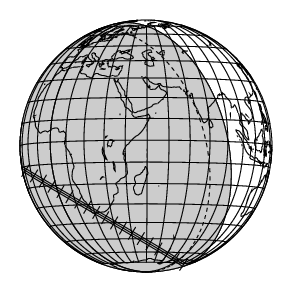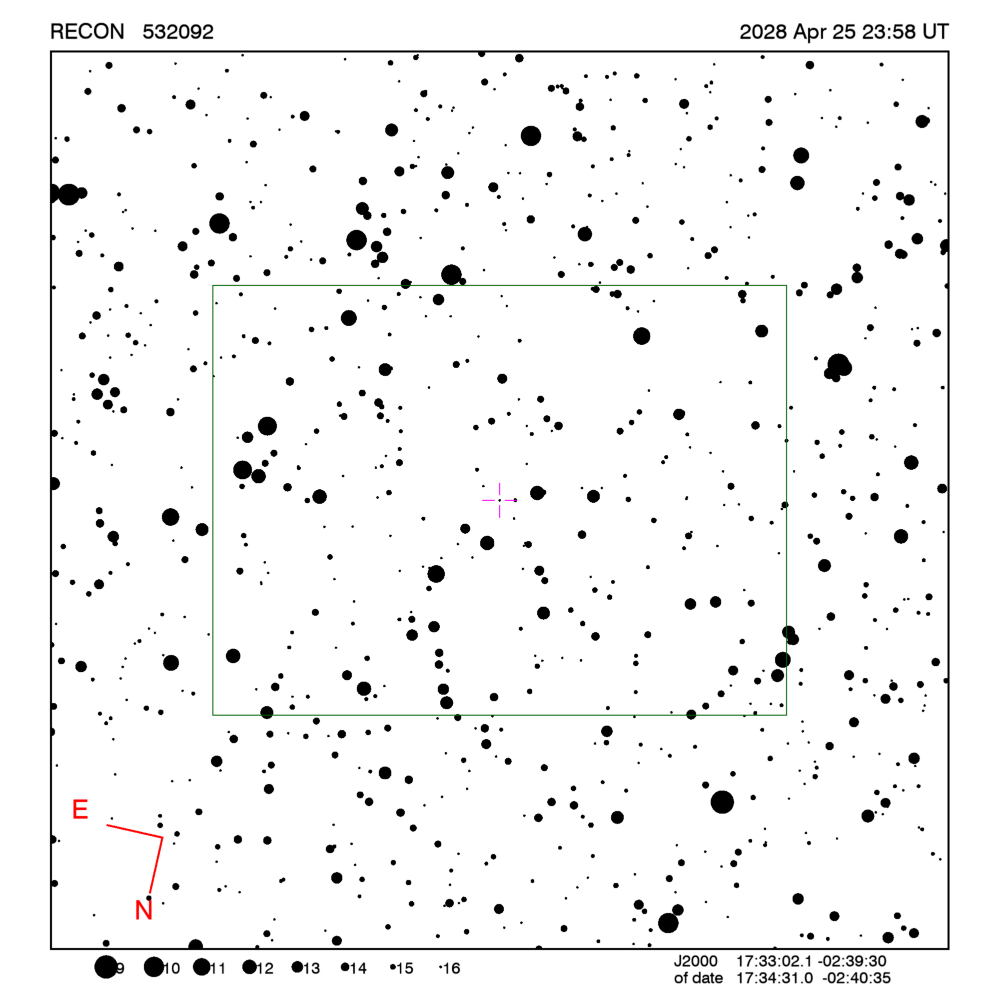RECON: TNO occultation with 532092
Event between (532092) 13HU156 and star GA0860:05749550
with event index number of 2161322
Geocentric closest approach at 2028/04/25 23:57:03 UTC
J2000 position of star is 17:33:02.1 -02:39:30
Equinox of date position of star is 17:34:16.3 -02:40:25
Stellar brightness G=16.6,
use SENSEUP=128 with the MallinCam and and exposure
time of 2 seconds with the QHY174 camera.
Star is 139 degrees from the moon.
Moon is 2% illuminated.
Apparent brightness V=21.6
 Object is 39.4 AU from the Sun
and 38.8 AU from the Earth.
Object is 39.4 AU from the Sun
and 38.8 AU from the Earth.
Apparent velocity is 17.2
km/sec on the sky relative to the star, or,
2.2 arcsec/hr.
The 1-sigma error in the time of the event is 109 seconds.
The 1-sigma cross-track error in the shadow position is
1503 km.
The object has an absolute magnitude Hv=5.5
Diameter=469.9 km assuming a 5% albedo -- 28.2 sec chord
Diameter=191.8 km assuming a 30% albedo -- 11.5 sec chord
Dynamical classification is 3:2E
Star training set for 532092, (2028/04/25 23:58UT)
Object RA Dec mag sep mel
Antares 16:31:08.9 -26:29:32 0.9 28.25 160
60Bet Oph 17:44:52.4 +04:33:27 2.8 7.68 133
PPM 180083 17:31:51.4 -01:05:01 6.2 1.73 139
PPM 200832 17:37:00.3 -02:54:29 8.0 0.66 139
PPM 200769 17:33:55.3 -02:46:44 9.7 0.18 139
PPM 200793 17:35:01.5 -02:39:46 10.2 0.13 139
532092 17:34:31.0 -02:40:35 16.6 139
Positions are for equinox of date

Azimuth is measured in degrees eastward from north.
North is at an azimuth of 0, due East is at an azimuth
of 90 degrees, due South is 180, and due West is 270.
Do not use the listing below for the RECON CPC 1100 telescopes.
This is provided for other non-team facilities.
Star training set for 532092, (2028/04/25 23:58UT)
Object RA Dec mag sep mel
Antares 16:29:24.4 -26:25:56 0.9 28.25 160
60Bet Oph 17:43:28.3 +04:34:06 2.8 7.68 133
PPM 180083 17:30:23.6 -01:03:50 6.2 1.73 139
PPM 200832 17:35:31.4 -02:53:30 8.0 0.66 139
PPM 200769 17:32:26.4 -02:45:38 9.7 0.18 139
PPM 200793 17:33:32.7 -02:38:42 10.2 0.13 139
532092 17:33:02.1 -02:39:30 16.6 139
Positions are for J2000
Event circumstances last updated at 2023/08/24 02:43:57 UT
Marc W. Buie,
Southwest Research Institute
RECON
 Object is 39.4 AU from the Sun
and 38.8 AU from the Earth.
Object is 39.4 AU from the Sun
and 38.8 AU from the Earth.
